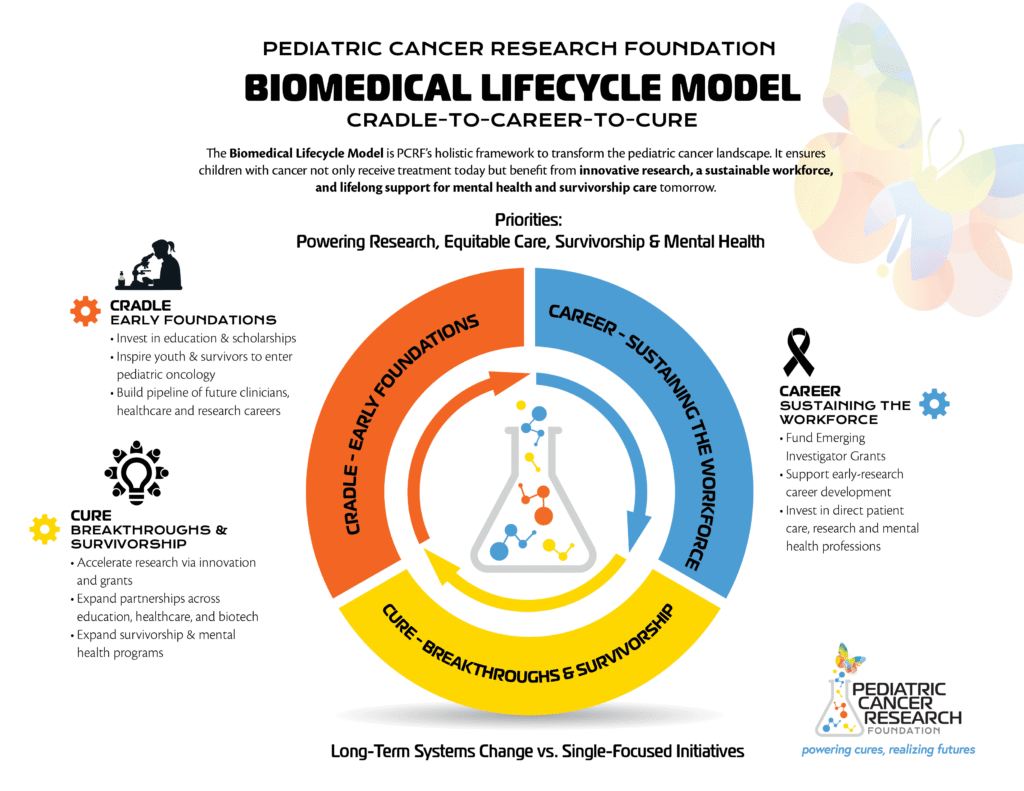By Bill Thomas | September 30
Earlier this year, Pediatric Cancer Research Foundation proudly announced its commitment to three new institutional priorities: powering research, healthcare equity, and survivorship and mental health support.
Over the last few weeks, as part of Pediatric Cancer Awareness Month, the Profectus Blog has shared several stories emphasizing the importance of these priorities, including a look at Dr. Brian Crompton’s PCRF-funded research into liquid biopsies for childhood cancer diagnosis, an examination of the rural-urban divide and how geography impacts childhood cancer care, and an overview of the many challenges facing childhood cancer survivors after their disease has gone into remission.
Today, Pediatric Cancer Research Foundation is excited to unveil the foundational model through which we reaffirm our commitment to our priorities and put into practice the innovative initiatives that will help us address the issues highlighted in the aforementioned Profectus posts, bolstering our vision of a future where children facing childhood cancers can overcome their disease and achieve their full potential so they can realize happy, healthy, productive futures
Today, we unveil our Biomedical Lifecycle Model: Cradle-to-Career-to-Cure.

What is PCRF’s Biomedical Lifecycle Model?
The Biomedical Lifecycle Model is the holistic framework that underpins everything Pediatric Cancer Research Foundation does. It is the bedrock structure that allows us to turn ideas into action, transforming the philosophies behind our guiding institutional priorities into practical, real-world progress.
Currently, the pediatric cancer community is facing crises on multiple fronts. First, there is a worrying decline in research funding, with less than 4% of all federal funds allocated for cancer research going towards pediatric cancers and an ongoing threat of additional NIH funding cuts. This, paired with high burnout and barriers to entry for those interested in healthcare, as well as the fact that many pediatric oncologists, nurses, and mental health providers are nearing retirement age, has resulted in significant healthcare workforce shortages.
Critical workforce shortages in pediatric oncology, in turn, limit care for patients across the United States, leading to delayed diagnoses and fragmented care, especially among rural and low-access populations. With 2 out of every 3 childhood cancer survivors facing long-term chronic health conditions, the need to support patients at all stages of care is more pressing now than ever before.
While many pediatric cancer nonprofits focus on just one stage of the pediatric cancer lifecycle–research, patient support, or survivorship–PCRF’s Biomedical Lifecycle Model is unique in that it integrates all stages into one cohesive lifecycle strategy. By linking education, workforce, research, and survivorship into one comprehensive framework, we can ensure that children with cancer not only receive treatment today but also benefit from stronger research, a sustainable workforce, and lifelong survivorship care tomorrow.

Cradle – Early Foundations
Here at Pediatric Cancer Research Foundation, we believe that a critical step in overcoming the challenges that face the childhood cancer community is addressing said challenges at their roots. Powering research, counteracting healthcare inequities, and supporting survivorship and mental health is simply not possible if hospitals, care centers, and research institutions don’t have the trained professionals they need.
That’s why the first pillar of PCRF’s Biomedical Lifecycle Model is a focus on initiatives that help us lay down the early foundations that tomorrow’s life-changing discoveries will be built on. We are investing in education and scholarships to inspire the youth and facilitate childhood cancer survivors entering the fields of pediatric healthcare and research. By building a pipeline of doctors, nurses, scientists, and mental health specialists, we are fostering a new generation of caregivers who will help us drive innovation.
Career – Sustaining the Workforce
The second pillar of the Biomedical Lifecycle Model centers around maintaining a healthy and productive pediatric cancer community infrastructure, one that is able to meet the needs of patients and their families while also providing a sustainable means of pushing forward with fresh ideas, critical advancements, and more effective, less toxic treatments.
To do this, Pediatric Cancer Research Foundation actively funds emerging investigators and clinicians, supports professional development and research careers, and works to strengthen an innovative and diverse pediatric oncology workforce. In the process, we are ensuring that groundbreaking and potentially life-saving work has the resources and opportunities it needs to grow into something truly game-changing.
Cure – Breakthroughs & Survivorship
The third pillar of the Biomedical Lifecycle Model is where all the groundwork we’ve laid and all the growth we’ve nurtured converts into functional, far-reaching breakthroughs. This is where we shepherd theoretical studies into clinical therapies, where we connect those who have resources with those who need them most, and where we ensure that support for pediatric cancer patients doesn’t stop just because their treatment is complete.
By accelerating research via innovation and translational grant funding, Pediatric Cancer Research Foundation is changing the way childhood cancers are understood, diagnosed, treated, and cured. By building partnerships and fostering collaborations between hospitals and cutting-edge biotechnology enterprises, we’re expanding access in underserved communities and growing the boundaries of pediatric cancer care. By expanding survivorship and mental health programs, we’re providing children and young adults who have been affected by pediatric cancers the means to thrive well into adulthood.

Revolutionizing Pediatric Cancer with the Biomedical Lifecycle
For more than 43 years, Pediatric Cancer Research Foundation has worked to improve material conditions for all members of the childhood cancer community, from patients, survivors, and their families to aspiring academics and emerging investigators. We recognize that to truly be effective, pediatric cancer care needs to be comprehensive. That’s what sets us apart and makes our Biomedical Lifecycle Model so revolutionary.
Thanks to the Biomedical Lifecycle Model, Pediatric Cancer Research Foundation is the only childhood cancer nonprofit that connects research funding, workforce pipelining, and survivorship care into one holistic approach. We’re not limited to single-focused initiatives; our goal is long-term systemic change, ensuring every limb of the childhood cancer community is cared for so that the entire body can grow healthier, happier, and more productive.
If you would like to help us power innovative research, ensure equitable care for all, or support childhood cancer survivors into adulthood, please consider becoming a donor. To stay up-to-date with all the latest news shaping the future of pediatric cancer treatment, don’t forget to follow Pediatric Cancer Research Foundation’s Profectus Blog!

